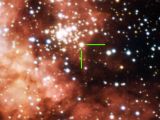The European Organization for Astronomical Research (ESO)'s Wide Field Imager (WFI) camera placed on the 2.2-m Max-Planck telescope from the La Silla observatory site, at an altitude of 2.4 km in the Chilean desert of Atacama, was able to obtain accurate photographs of one of the most massive binary star systems. The two stars are located inside a small cluster by the name of Westerlund 2, in the center of the Gum 29 ample star nursery found on the outer edge of Milky Way's Carina arm.
The Gum 29 region (called as such because it represents the 29th entry in the catalog that, since 1955, bears the name of its creator, the Australian astronomer Colin Stanley Gum) is a HII (H two) zone, namely a vast chunk of space filled with ionized (emptied of electrons) hydrogen gas that spans about 200 light years. The Westerlund 2 section unfolds approximately 26,000 light years away from our planet, but the most surprising thing is that it is aged between 1 and 2 million years, younger than hominid species.
The location of the dual star system (which looks like a light globe, although it is comprised of 2 cosmic bodies) is indicated by the 2 green lines in the image to the left. Both stars which form the double system have enormous masses – one is 82 and the other 83 times bigger than our Sun, placing them among the largest stars known so far – and they spin around each other in a cycle that lasts for the duration of about 3.7 days.
After a thorough analysis, the odd couple has been discovered to belong to a category known as Wolf-Rayet stars, which comprises giant stars that are close to the end of their evolution and eject enormous amounts of material from their own bodies in the process. X-ray observations have shown that the material coming from the 2 members of the double star system constantly collides and emits enormous X-ray flares.

 14 DAY TRIAL //
14 DAY TRIAL // 
